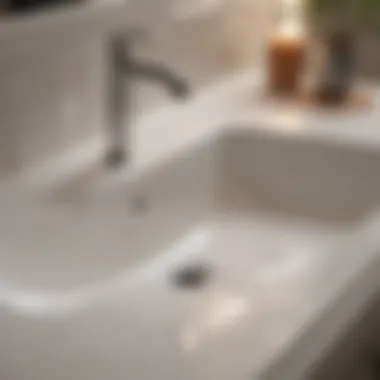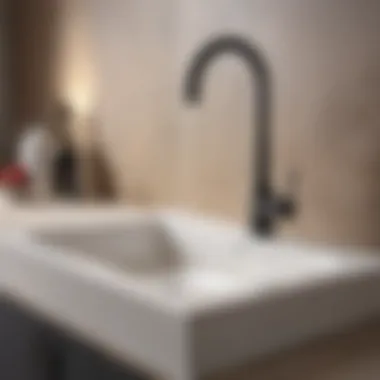Cleaning a Stained White Ceramic Sink: A Comprehensive Guide


Intro
Cleaning a stained white ceramic sink is not just about aesthetics; it’s a measure of keeping a hygienic environment in your kitchen or bathroom. A ceramic sink, while known for its elegant appearance, can quickly show dirt, stains, and discoloration from everyday use. As the charm of these sinks comes with the challenge of maintaining their pristine condition, understanding the essentials of cleaning can make a significant difference.
When stains accumulate, they can alter the appearance of a sink and even affect its functionality. Therefore, learning effective cleaning methods, understanding the types of stains, and knowing which products to use are all crucial for restoring your sink's original sheen. This guide aims to equip homeowners and renters with the necessary knowledge to tackle this task efficiently.
In the following sections, we will cover key insights into stain removal, practical cleaning techniques, and maintenance tips to minimize future staining. The objective is to provide a comprehensive overview that not only aids in immediate cleaning but also promotes long-term care of your ceramic sink.
Preface to Ceramic Sinks
Ceramic sinks are an increasingly popular choice in many homes due to their aesthetic appeal and durability. Understanding the material's properties can significantly influence both the care and maintenance of these sinks. This section provides the foundational knowledge about ceramic material and the reasons why many households opt for white ceramic sinks.
Understanding Ceramic Material
Ceramic is a composite material made primarily of clay. It is fired at high temperatures, which results in a strong and durable finish. The non-porous surface of ceramic gives it an advantage over other materials, as it is more resistant to stains and odors. Additionally, ceramic can withstand considerable temperature variations without cracking, making it ideal for busy kitchens. However, despite its robustness, it can still be prone to scratching and chipping if not handled with care. Therefore, while ceramic sinks offer many benefits, users should be mindful of their handling to maintain their appearance over time.
Benefits of White Ceramic Sinks
White ceramic sinks come with various advantages that cater to both functionality and design. Here are some key benefits:
- Timeless Aesthetic: The classic white finish allows these sinks to fit seamlessly into different interior designs, from traditional to modern.
- Easy to Clean: The smooth surface repels dirt and helps prevent stains from settling in. This quality makes cleaning and maintenance simpler compared to other sink materials.
- Glossy Finish: The glossy glaze not only enhances the appearance but also adds a layer of protection against various stains.
- Resistance to Heat: Ceramic sinks can tolerate hot water and pots without warping, making them highly practical in a kitchen setting.
Overall, understanding the unique characteristics of ceramic sinks, particularly white ones, contributes to better maintenance practices. Homeowners, designers, and hosts can appreciate how ceramic sinks can serve both utility and decoration without sacrificing longevity.
Common Stains Found in Ceramic Sinks
Understanding the types of stains that can occur on ceramic sinks is crucial for effective cleaning and maintenance. Different stains have various causes, and these need tailored approaches to remove them properly. By identifying the type of stain present, one can apply appropriate cleaning techniques and products, which prevents potential damage to the sink's surface. This knowledge is particularly beneficial for homeowners looking to maintain the aesthetics and longevity of their white ceramic sinks.
Hard Water Stains
Hard water stains are often one of the primary concerns for ceramic sink owners. These stains occur when minerals, primarily calcium and magnesium, precipitate on the sink's surface after water evaporates. They generally appear as cloudy spots, and if left untreated, can create a dull, unappealing appearance. To effectively combat hard water stains, it is important to recognize that frequent exposure to water increases the likelihood of these mineral deposits. Regular cleaning can help prevent the build-up of these stains.
A proactive approach can keep hard water stains at bay, maintaining the brilliance of your ceramic sink.
Food and Beverage Stains
Such stains arise from the remnants of food and drinks. The most common culprits include coffee, wine, berries, and sauces, which can leave significant discoloration if not addressed promptly. Being vigilant about cleaning the sink after meal preparation or post-entertainment activities will significantly minimize the impact of these stains. Using gentle cleaners tailored for ceramic surfaces can restore the sink's luster without causing damage.
Soap Scum and Grease


Soap scum and grease are natural consequences of regular use. Soap interacts with hard water to form residues that cling to surfaces, particularly in the corners and around the faucet area. Grease, often left behind from food preparation, can create sticky patches. Both of these stains necessitate specific cleaning methods. Regularly scrubbing these areas with suitable non-abrasive cloths or sponges after each use will go a long way in maintaining a clean sink.
In summary, identifying the stains that commonly affect ceramic sinks enables homeowners to adopt effective cleaning strategies. Regular maintenance is essential to preventing stains from becoming a more significant issue.
Essential Tools and Products for Cleaning
Cleaning a stained white ceramic sink requires the right tools and products to achieve desired results. Having the correct items ensures effectiveness and makes the cleaning process efficient. This section will delve into recommended supplies and homemade solutions, which can be vital for maintaining your sink.
Recommended Cleaning Supplies
Choosing the right cleaning supplies can make a significant difference in the ease of removing stains and maintaining the sink's appearance. Key products include:
- Non-abrasive sponge or cloth: These help avoid scratching the ceramic surface.
- Liquid dish soap: A gentle cleanser effective in cutting through grease and soap scum.
- Baking soda: This mild abrasive acts as a stain fighter and deodorizer.
- White vinegar: Excellent for breaking down hard water deposits and other stains.
- Hydrogen peroxide: Useful for disinfecting and brightening the sink without sacrificing its surface.
- Commercial ceramic cleaners: Products like Rejuvenate and Zep can aid in tough stains but should be used sparingly. Always check labels for compatibility.
The selection of supplies should cater to specific stains found in ceramic sinks, such as food, soap scum, and hard water stains. Remember that while commercial products can be effective, homemade solutions are often safer and more environmentally friendly.
Homemade Cleaning Solutions
For those who prefer natural options, several homemade cleaning solutions can perform admirably on ceramic sinks. Their simplicity and cost-effectiveness are appealing. Here are some notable recipes:
- Baking Soda Paste: Mix baking soda with water to create a paste. Apply it to stained areas and let it sit for a few minutes before scrubbing gently.
- Vinegar Spray: Combine equal parts white vinegar and water in a spray bottle. Spritz the solution on stains, allowing it to sit before wiping down. This method is particularly effective against hard water stains.
- Lemon Juice and Salt: Lemon juice's acidity can break down stains, while salt adds gentle abrasion. Mix the two for a powerful stain-removing paste that tackles tougher spots.
Homemade solutions can be surprisingly effective, offering a safe and cost-effective means to maintain a clean sink.
Using these recommended supplies and homemade solutions not only assists in cleaning but also fosters good maintenance habits. Proper care methods can prolong the life of a ceramic sink, keeping it looking fresh and new for a more extended period.
Step-by-Step Cleaning Process
Cleaning a white ceramic sink requires a methodical approach to ensure effective and safe results. The step-by-step process outlined here not only restores the cleanliness of the sink but also aids in preventing future stains. By following these steps systematically, you engage in a thorough cleaning experience, which can substantially extend the life of your sink and maintain its aesthetic appeal.
Initial Rinse and Wipe Down
The first step in the cleaning process is crucial. Begin by rinsing your ceramic sink with warm water to remove any loose debris or food particles. This initial rinse is beneficial because it prepares the surface, making it easier for any cleaning solution to penetrate. After rinsing, use a soft cloth or sponge to wipe down the entire sink surface. This action helps to lift any grime that may not be visible. It is essential to avoid using abrasive materials to prevent scratching the ceramic.
Applying Cleaning Solution
Once the sink is prepped, the next step is applying the chosen cleaning solution. If you have decided to utilize a commercial cleaner, ensure that it is safe for ceramic surfaces. Alternatively, homemade solutions with vinegar or baking soda can be effective. Spray or pour the solution generously over all stained areas, making sure to cover spots that often attract buildup, such as the edges and the drain area. The contact time for the solution is important; let it sit for about 10-15 minutes. This waiting time allows the cleaner to break down stains effectively.
Scrubbing and Removing Stains


After letting the cleaning solution work, it is time to scrub. Use a non-abrasive sponge or a soft-bristle brush to scrub the sink surfaces gently. Pay particular attention to stubborn spots that may require a bit more effort. Using circular motions can help lift even the most persistent stains. If you encounter exceptionally tough stains, consider repeating the application of the cleaning solution in those areas. It is important to remain patient during this process, as rushing may lead to incomplete stain removal.
Final Rinse and Drying
The last step involves rinsing the sink thoroughly with warm water. Ensure all cleaning solution residues are removed, as any leftover product can lead to dulled appearance over time. After rinsing, dry the sink with a clean and soft towel. Not only does drying prevent water spots, it also leaves the sink shining. Consider finishing with a touch of mineral oil or a ceramic-safe polish to maintain shine and protect the surface from future stains.
"Consistent care is key to keeping your ceramic sink looking new. Regular cleaning can save you from tougher jobs later on."
Overall, these steps not only help in maintaining the sink's cleanliness but also enhance its longevity. Setting a routine in upkeeping your sink will yield noticeable results over time, prompting a welcoming space in your kitchen or bathroom.
Addressing Stubborn Stains
Dealing with stubborn stains in a white ceramic sink is a common concern for many homeowners. Over time, these stains can accumulate and create an unsightly appearance, detracting from the sink's overall aesthetic. The focus on this topic is essential because persistent discolorations can affect not only the visual appeal but also the functionality of the sink. Understanding how to effectively address these stains is critical for restoring and maintaining the surface of the sink, thereby extending its lifespan.
Stubborn stains often stem from hard water deposits, food particles, or chemical residues. A comprehensive approach to cleaning these stains involves understanding the nature of the stains and the appropriate methods to tackle them.
Using Baking Soda and Vinegar
Baking soda and vinegar are two household staples that create a powerful cleaning duo. When combined, they produce a chemical reaction that helps lift and dissolve tough stains in a ceramic sink.
- Preparation: Start by removing any loose debris from the sink with a soft cloth.
- Application: Sprinkle baking soda generously over the stained area. Follow this by spraying white vinegar onto the baking soda.
- Wait: Allow the mixture to fizz and work for about 10-15 minutes. This reaction will help break down the stain.
- Scrubbing: After the waiting period, take a soft-bristle brush or a sponge to gently scrub the area. Be careful not to use anything abrasive that could scratch the ceramic.
- Rinsing: Finish by rinsing the sink thoroughly with warm water to remove all residues.
This method is not only effective but also safe for the environment and does not involve harsh chemicals.
Chemical Cleaners: Best Practices
When stubborn stains resist natural remedies like baking soda and vinegar, chemical cleaners may be necessary. Using them requires care to avoid damage to your sink and ensure effective cleaning. Here are some best practices to consider:
- Selection: Choose chemical cleaners specifically designed for ceramic surfaces. Products like Comet Cleaner or Clorox Clean-Up can be effective. Read the label to ensure compatibility with ceramic.
- Application: Apply the cleaner according to the manufacturer's instructions.
- Ventilation: Always ensure good ventilation when using chemical cleaners, as fumes can be unpleasant and harmful. Open windows or use fans for air circulation.
- Test Area: Before applying to the entire stained surface, test the product on a small, inconspicuous area to check for any adverse reactions.
- Protection: Wear gloves to protect your skin and avoid contact with the cleaner.
Using chemical cleaners can be effective, but they should only be used as a last resort after trying natural approaches.
Following these practices will help maintain your ceramic sink while effectively addressing those stubborn stains, ensuring it stays clean and beautiful for longer.
Preventive Measures for Maintaining a Clean Sink
Maintaining a clean sink goes beyond occasional scrubbing. Preventive measures play a vital role in preserving the aesthetic appeal and functionality of a white ceramic sink. By integrating these strategies into your routine, you can mitigate the buildup of hard water stains, grease, and food residues. This not only enhances the sink's appearance but also prolongs its lifespan. Regular attention to cleanliness can save you considerable effort in dealing with stubborn stains later.
Regular Cleaning Schedule


Establishing a regular cleaning schedule is fundamental to sink maintenance. Consider designating specific days for cleaning. This system creates a habit, making it easier to stay on top of messes. For instance, a quick wipe-down with a mild cleaner each week keeps the surface fresh and reduces the chances of prolonged staining.
- Daily care: Rinse the sink after each use. This simple step can minimize residue buildup.
- Weekly cleaning: Set aside time to scrub the sink with a suitable cleaner. Focus on corners and edges where grime can accumulate.
- Monthly deep clean: A more thorough clean once a month helps tackle any persistent stains and maintain shine.
Implementing a cleaning schedule not only makes the task manageable but also instills a sense of discipline in routine maintenance.
Protective Coatings and Sealants
Applying protective coatings and sealants can be an effective strategy for maintaining the clarity of a white ceramic sink. These products create a barrier between the surface and potential staining agents. They can impede the absorption of stains, making cleaning processes much easier.
When selecting a protective coating:
- Choose a product designed specifically for ceramic materials. Not all coatings are suitable for every surface type.
- Ensure the coating is non-toxic and safe for kitchen use, especially if the sink is in frequent contact with food.
- Reapply the protective coating according to manufacturer recommendations, as wear can reduce effectiveness over time.
Utilizing protective coatings not only enhances cleanliness but also contributes to a visually appealing finish that can make any kitchen stand out.
End
In this guide, understanding how to clean a stained white ceramic sink not only addresses immediate aesthetic concerns but fosters a longer-term relationship with your home environment. This task may seem mundane, yet it carries significant weight in maintaining the overall appeal and functionality of your kitchen or bathroom. A clean sink reflects care, attention to detail, and contributes positively to a homeowner's well-being.
Keeping your ceramic sink spotless is paramount due to its vulnerability to various stains. From hard water blemishes to food remnants, each mark can diminish the sink's beauty over time. Moreover, neglecting proper cleaning can lead to more stubborn stains that require extensive effort to remove.
Key aspects to consider include:
- Regular cleaning is the first step toward preventing buildup and maintaining a pleasant appearance.
- The use of proper cleaning tools and materials can enhance the efficiency of your cleaning routine. Employing both natural solutions, like baking soda and vinegar, and commercial products should be considered based on the stain types encountered.
- Implementing preventive measures such as protective coatings can increase the longevity of your sink's pristine surface.
Ultimately, proper care translates into a cleaner, healthier space that resonates with aesthetic sensibility.
Summary of Key Points
- Cleaning Frequency: Establish a regular cleaning schedule to circumvent severe staining.
- Stain Types: Familiarizing yourself with the types of stains prevalent in ceramic sinks aids in selecting the right cleaning approach.
- Cleaning Products: Opt for suitable products, whether store-bought or homemade, to ensure effective cleaning without damaging the sink’s surface.
- Long-Term Maintenance: Consider applying sealants or using matting to protect the sink from everyday wear and tear, thus preserving its condition.
Efficient sink cleaning enhances functionality and preserves your ceramic sink’s allure, contributing to a more harmonious home environment.
Encouragement for Consistent Care
Continuous attention to your ceramic sink will yield significant rewards. By committing to a cleaning routine, you assure that your sink remains in excellent shape. Think of consistent care as a small investment yielding substantial returns in terms of aesthetics and durability.
Every time food waste, dirt, or water spots appear, reflect on how a quick routine can revert your sink to its shining state. Remember, it's easier to prevent stains than to rectify them.
Being proactive will save time and effort in the long run. Make cleaning part of your weekly chores. It will soon become second nature. It fosters an environment that feels clean and welcoming.
Ultimately, a well-maintained sink enhances the overall ambiance of your space, allowing you to immerse yourself fully in your home surroundings.
"In the realm of home maintenance, simplicity reigns. A few minutes regularly can result in hours of joy in a clean, functional space."
By implementing the strategies learned in this guide, you're well-equipped to maintain the aesthetic and functional integrity of your white ceramic sink.



